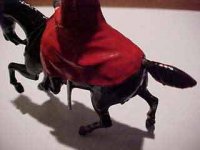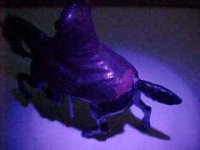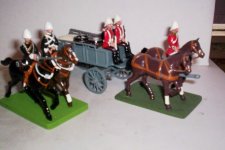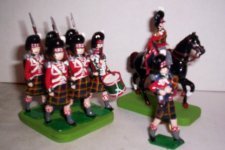ROAN
Specialist
- Joined
- Mar 30, 2007
- Messages
- 302
Just joined this forum(normally post over at the ToySoldierchat.com forum but they’re apparently down).
I’d like to throw the following out for discussion and see what you collectors of old Britains or even other old toy soldier collectors out there have to say about it.
For those of you who collect Britains or other old toy soldiers and figures you’ve probably heard the general rule that if a figure has been touched-up it considerably lessons its value. The same rule, generally applied, goes for repairs, however well it’s done(for some raising value or investment issues is like waving a red flag, but am sure most collectors think about this at least once in awhile).
Because of this, some years ago I purchased an ultra-violet(UV) light or “black light” ; a little portable job that’s small enough to hang on a key chain (just google if you want one-I forgot now where online I bought mine) and use it to detect touch-ups, embellishments, repairs, etc. on the figures I want to buy. I found this to be a valuable tool-mail order dealers usually have a no-questions-asked-return policy(some have UV lights also so they can verify your claim about a touch-up).
I was really excited about the possibilities of UV lights and even posted some photos illustrating an example of UV touch-up detection on my website(see attached photos below).
But, lo and behold, I also found that there were limits to detecting what is a touch-up and what’s not-at least in the case of pre-1966 Britains.
Case in point: I bought a set made toward the end of Britains hollow-cast lead production(probably circa 1963-66) that was in one of those “window boxes” that Britains used after 1961. This was a “shop mint” set, that as far as I could tell, had never been removed from its box and had never even been opened.
But alas, moving my UV light over the set, all the red paint on the figures fluoresced, a “sure” sign of a touch-up(again, look at the photo examples).
Was this a touch-up? Looking over the set with a high powered magnifying glass, I began to have doubts. The red paint on the lips fluoresced, which meant that, if this indeed was a touch-up, the toucher-upper or whatever painstakingly removed each piece from the box, touched up only the red parts(busbies, lips-what a pervert!)then retied the figures, closed the box flaps- all without leaving any of the usual tell-tale traces.
Question: why just touch up these parts-the rest of the paintwork is pristine(and does not fluoresce)and is free from scratches. And all this for a fairly common set that only retailed for around a hundred bucks!
Which led me to conclude that because of the relatively late manufacture of this set, Britains probably started using the modern, lead-free oil based glossy paints that fluoresce under a UV light(and so the ability to detect touch-ups). Although a dealer I use doesn’t agree with my theory, some subsequent sets I’ve acquired that were made around the same time as the set described above contain figures with paint that also fluoresces(does anyone out there have any info about the kind of paints Britains used toward the end of the mid-sixties?).
While I’m on the subject(and I promise to end this soon)besides the above, there are also many anomalies one may encounter in collecting old Britains.
For example, sets with figures that have slight mismatched paint(esp. the “rosy cheek” color and the green on the bases)from the others. Usually, you would conclude that not all the figures were original to this box. But at the Britains factory, occasionally they did add a mismatched figure to a set-esp. an officer figure or one that came from a different mold from the others. Britains also, on occasion, added a substance to figures which heightened their glossiness,-which also shows up under a UV light.
They also used(right before the war and after)really cheap boxes that were neither red nor shiny-and used tie cards with a variety fasteners and Britains logo stamps(I wish the Vectis appraisers would learn this fact-just go into their site and type in “reproduction tie-card” and see how many sets from past auctions will come up. This isn’t to say that there aren’t repro tie cards out there). All anomalies-but to some this would smell of forgery, fraud, deceit.
Here’s what I think about these types of anomalies: what do you expect from a hand made, hand painted(or sprayed)product, that at one time was produced, by many different people, in the millions per month? And as far as UV lights, they can tell lies.
I’d like to throw the following out for discussion and see what you collectors of old Britains or even other old toy soldier collectors out there have to say about it.
For those of you who collect Britains or other old toy soldiers and figures you’ve probably heard the general rule that if a figure has been touched-up it considerably lessons its value. The same rule, generally applied, goes for repairs, however well it’s done(for some raising value or investment issues is like waving a red flag, but am sure most collectors think about this at least once in awhile).
Because of this, some years ago I purchased an ultra-violet(UV) light or “black light” ; a little portable job that’s small enough to hang on a key chain (just google if you want one-I forgot now where online I bought mine) and use it to detect touch-ups, embellishments, repairs, etc. on the figures I want to buy. I found this to be a valuable tool-mail order dealers usually have a no-questions-asked-return policy(some have UV lights also so they can verify your claim about a touch-up).
I was really excited about the possibilities of UV lights and even posted some photos illustrating an example of UV touch-up detection on my website(see attached photos below).
But, lo and behold, I also found that there were limits to detecting what is a touch-up and what’s not-at least in the case of pre-1966 Britains.
Case in point: I bought a set made toward the end of Britains hollow-cast lead production(probably circa 1963-66) that was in one of those “window boxes” that Britains used after 1961. This was a “shop mint” set, that as far as I could tell, had never been removed from its box and had never even been opened.
But alas, moving my UV light over the set, all the red paint on the figures fluoresced, a “sure” sign of a touch-up(again, look at the photo examples).
Was this a touch-up? Looking over the set with a high powered magnifying glass, I began to have doubts. The red paint on the lips fluoresced, which meant that, if this indeed was a touch-up, the toucher-upper or whatever painstakingly removed each piece from the box, touched up only the red parts(busbies, lips-what a pervert!)then retied the figures, closed the box flaps- all without leaving any of the usual tell-tale traces.
Question: why just touch up these parts-the rest of the paintwork is pristine(and does not fluoresce)and is free from scratches. And all this for a fairly common set that only retailed for around a hundred bucks!
Which led me to conclude that because of the relatively late manufacture of this set, Britains probably started using the modern, lead-free oil based glossy paints that fluoresce under a UV light(and so the ability to detect touch-ups). Although a dealer I use doesn’t agree with my theory, some subsequent sets I’ve acquired that were made around the same time as the set described above contain figures with paint that also fluoresces(does anyone out there have any info about the kind of paints Britains used toward the end of the mid-sixties?).
While I’m on the subject(and I promise to end this soon)besides the above, there are also many anomalies one may encounter in collecting old Britains.
For example, sets with figures that have slight mismatched paint(esp. the “rosy cheek” color and the green on the bases)from the others. Usually, you would conclude that not all the figures were original to this box. But at the Britains factory, occasionally they did add a mismatched figure to a set-esp. an officer figure or one that came from a different mold from the others. Britains also, on occasion, added a substance to figures which heightened their glossiness,-which also shows up under a UV light.
They also used(right before the war and after)really cheap boxes that were neither red nor shiny-and used tie cards with a variety fasteners and Britains logo stamps(I wish the Vectis appraisers would learn this fact-just go into their site and type in “reproduction tie-card” and see how many sets from past auctions will come up. This isn’t to say that there aren’t repro tie cards out there). All anomalies-but to some this would smell of forgery, fraud, deceit.
Here’s what I think about these types of anomalies: what do you expect from a hand made, hand painted(or sprayed)product, that at one time was produced, by many different people, in the millions per month? And as far as UV lights, they can tell lies.
Attachments
Last edited:





